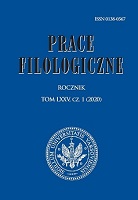Wokół opisu cech walencji czasowników typu: pol. ściemnieć, wygładzić się; bułg. изруся се, изгладя се
Towards description of the valency features of verbs such as Polish ściemnieć, wygładzić się and Bulgarian изруся се, изгладя се
Author(s): Małgorzata KorytkowskaSubject(s): Syntax, Semantics, Comparative Linguistics, Western Slavic Languages, South Slavic Languages, Philology
Published by: Wydział Polonistyki Uniwersytetu Warszawskiego
Keywords: relation part; whole; predicate-argument structure; one-place predicate; argument expression; Polish-Bulgarian contrast;
Summary/Abstract: The article covers a semantic and syntactic interpretation of sentence structures expressing part : whole relation with respect to an animate subject ([+anim / and +hum] traits), and the subject’s body parts, e.g. Włosy Piotrusia ściemniały. (with the variant Włosy Piotrusiowi ściemniały.). The author refers to theoretical grounds of predicate-argument syntax, including the fundamental model introduced by S. Karolak. Structures like this, in which predicates constituting sentence structures open one argument position, can be interpreted in two ways. What is discussed in particular is the structure of this argument, as well as of its counter-parts in the Bulgarian language. In addition, the discussion covers another verb type (boleć ‘to ache, to hurt’), which also opens a position for one semantically compound argument in S. Karolak’s classification. In the author’s view the inclusion ofczuć / doznawać (‘to feel’) component into the semantic structure of these verbs indicates that they are two-argument predicates.
Journal: Prace Filologiczne
- Issue Year: 75/2020
- Issue No: 1
- Page Range: 313-322
- Page Count: 10
- Language: Polish

